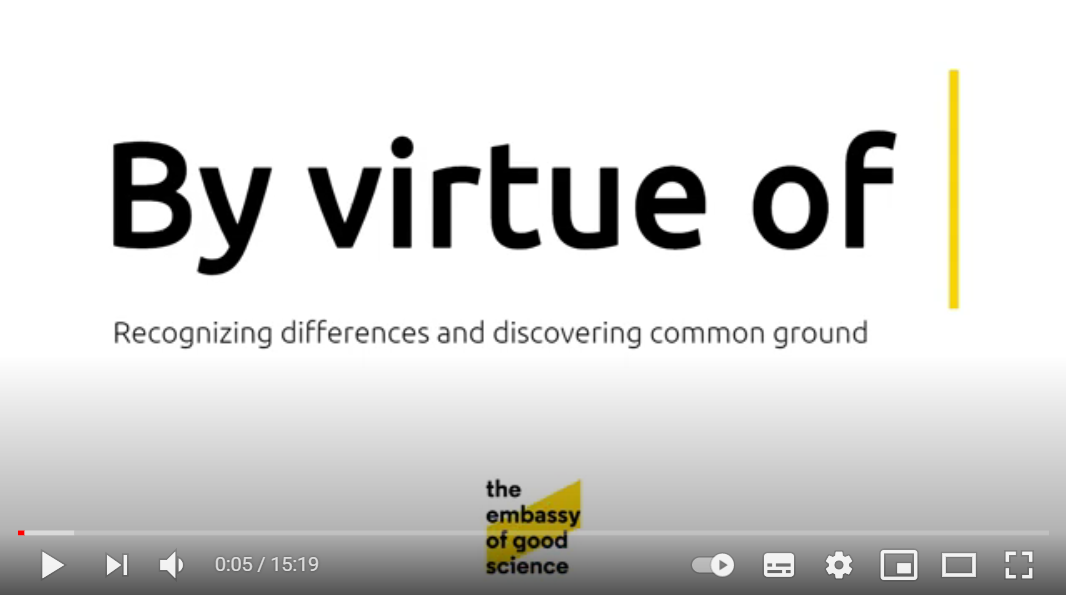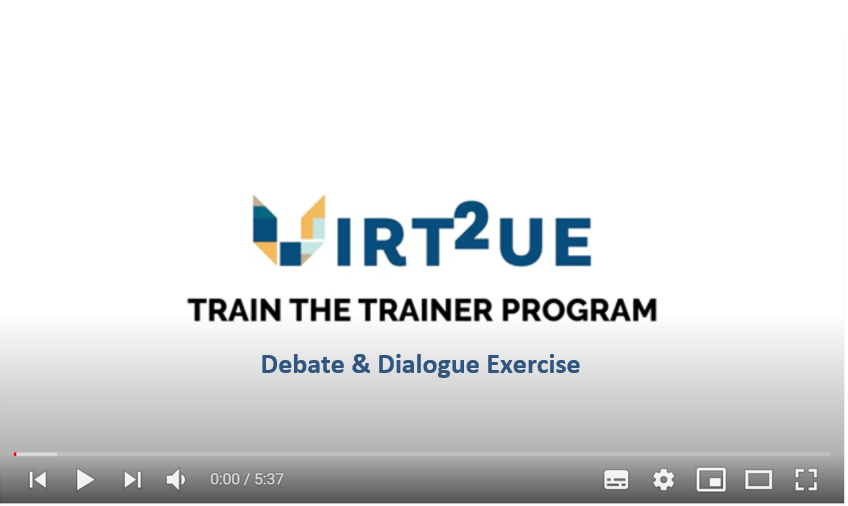Difference between revisions of "Instruction:Ac206152-effd-475b-b8cd-7e5861cb65aa"
| Line 53: | Line 53: | ||
{{Instruction Step Trainee | {{Instruction Step Trainee | ||
|Instruction Step Title=Annotated Debate vs. Dialogue Video | |Instruction Step Title=Annotated Debate vs. Dialogue Video | ||
| − | |Instruction Step Text= | + | |Instruction Step Text=The below video describes the difference between a debate and a dialogue. Click on the annotations to learn more throughout the video. |
| − | |||
| − | |||
| − | |||
| − | |||
| − | |||
|Instruction Step Interactive Content=Resource:H5P-5 | |Instruction Step Interactive Content=Resource:H5P-5 | ||
}} | }} | ||
Revision as of 12:18, 15 April 2024
Debate and Dialogue
You should have read the instructions before experiencing the exercise. You should also be familiar with :
a) The concept of moral dilemma;
b) The concept of dialogue.
For this exercise, you should have a background in research (i.e. be employed as a researcher) or be a trainer/educator/teacher who has had experience in research in the past.What is this about?
Why is this important?
Prepare
Watch the video to get an impression of the VIRT2UE 'Debate & Dialogue Exercise'.
Debate and dialogue are two different communicative modes. The following video explores the differences between the two and helps the viewer develop a better understanding of their dynamics. These differences are also described in more detail in the theme page 'dialogue versus debate'.

Experience the exercise
The trainer will facilitate the exercise by following the steps briefly listed here below:
- Introduction to the exercise
- Presentation of an exemplary case with a clear moral dilemma.
- Creation of subgroups (you will be asked to defend one of the two options in the dilemma)
- Participants engage in a debate
- Reflection on the process of debating
- Explanation of the characteristics of a dialogue
- Participants engage in a dialogue
- Reflection on the differences between debate and dialogue
- Reflection on the value of dialogue in group reflections.
Evaluate
Share your experiences of participating and facilitating the exercise with the other participants.
Annotated Debate vs. Dialogue Video
The below video describes the difference between a debate and a dialogue. Click on the annotations to learn more throughout the video.
Remarks
List of contributors:
Margreet Stolper, Giulia Inguaggiato.
We thank Rea Scepanovic, Marco Consentino, Vasalis Markakis, Armin Schmolmeuller, Ruzica Tokalic, Erika Löfström and Solveig Cornér for their constructive feedback during the process of developing!
This training has been developed by the VIRT2UE project, which has received funding form the European Union’s H2020 research programme under grant agreement N 741782.
This exercise has been translated in Turkish.What is this about?
This exercise helps trainers to develop their own, and other's, dialogical skills. The exercise is based on the premise that dialogue and dialogical skills are indispensable for reflection and deliberation processes in general, and for research integrity in particular. In learning how to facilitate this exercise, you will be able to:
- Conduct a dialogue and know how to support/encourage the use of dialogue as a tool for reflection processes.
- Foster reflection in others by means of experiential learning;
Why is this important?
Practical Tips
| Case example which you can use:
You are applying for a grant to fund your research. One of your colleagues is known for being very good at writing convincing applications. You ask him for help, as you really need the grant. He is very willing to give you a hand and rewrites your application. When reading his changes, you get the feeling that it is very ambitious and it promises a lot which you might not be able to deliver. However, you have to admit that the application is really impressive and convincing. The deadline for handing in the application is tomorrow. What do you do?
B) Submit the original version. Overview of differences between Debate and Dialogue
Instructions step 8: Questions that might help guide a reflection on a dialogical attitude:
|
Introduction
Introduce the exercise by explaining its goals (recognizing a moral dilemma, experiencing the difference between debate and dialogue, and understanding the value of dialogical attitude for fostering reflection in others) and explain the importance for research integrity. Make clear that for this exercise it is important to focus primarily on the process of the interaction. That means that the content of the case is of secondary importance and will mainly be used to foster a process of debate and/or dialogue.
Case presentation
Present an example (hypothetical) research integrity case with a clearly formulated moral dilemma (please see practical tips for an example). While choosing a case, be aware of the target group. Pick a case that is recognizable for the target group - it should be part of their practice. It is important to choose a case which is short and has a clearly formulated dilemma (2 clear choices). Display the case description clearly on a monitor during the debate/dialogue. Participants should be able to re-read the case description at any time. Make sure you give enough information about the case, otherwise participants will start to ask questions about the case itself.
Creation of subgroups
Divide the group in two sub-groups and instruct each group which side of the dilemma they have to defend. There are two ways to split the group: A) participants choose a side themselves, or B) the trainer divides the group in two subgroups. Both approaches have pros and cons to consideration. With option A, the participants are more likely to believe in and strongly defend their position. With option B, the participants have to learn to defend a position which they might not agree with.
If you are aware of power differences in a group e.g. supervisors and (PhD) students, it might be advisable for the moderator to divide the group. Participants assigned to a group might feel less pressure when defending their position against people more powerful than them.
If there is enough space available in the room, position the two subgroups facing each other; they should literarily stand facing each other.
Before starting the debate, give both groups a few minutes to discuss their arguments and strategy to convince the other group.Experiencing a debate
Start a debate: invite both subgroups to convince the other side of their position. As a moderator, you can challenge the participants if only a few people talk. In general, try not to intervene too much during the debate, even when participants start raising their voices. Stop the debate if you see people becoming too emotional and ask them what is triggering them to become emotional in terms of aggression, sadness etc.
In case the participants are debating too politely, you should intervene actively as a moderator and challenge both groups to convince each other. You might even make stimulating comments such as:
- Come on, do you really think that …….? (repeat what has been said by one of the participants)
- What makes you think that this argument counts?
Reflecting on the features of a debate
After 10-minutes (depending on the size of the group), stop the debate and let the group reflect on what happened and how they debated/interacted with each other. Help them to reflect mainly on the process and not on the content of the debate. Ask participants to list features of a debate and note them down on a flip-chart. Some examples of questions you might use:
- What was remarkable in the way you talked to each other? What did you observe/experience?
- What did you notice about people's postures or tones of voice?
- How would you characterize the interactions between the two groups? What did you observe/experience?
- Do you feel you understand each other?
- Which group was dominant and why did this happen? It might happen that one group is always confronting the other group, while the other group is always defending their position instead of ‘attacking’ the other group. Try to identify with the participants what contributed to this process.
- While listing and reflecting on the characteristics of a debate, try to ask for examples. For example, you can ask, what did you see or experience? What was missing?
Introducing features of a dialogue
Turn the focus to a dialogue and present the characteristics of a dialogue: slowing down, listening instead of telling, postponing judgment, asking questions (see practical tips). You can distribute an overview of the differences between a debate and a dialogue among the participants (see practical tips).
Experiencing a dialogue
Let both subgroups talk again with each other for about 10 minutes but now with a dialogical attitude. Preferably, stay with the same case and the same groups as in step 3. Although it might be difficult, participants are actively challenged to change in their attitude (from debate to dialogue). It is also possible to use a new case and designate again groups defending the difference sides of the dilemma. Presenting a new case might be easier for participants adopt a dialogical attitude.
In general, people tend to start debating with each other again. Therefore, be alert to the attitude of a debate and intervene immediately when participants start debating during the time for dialogue. For example, participants who interrupt others, don't listen, attach others with judgmental sentences/postures/gestures, or defend themselves instead of asking questions for clarification etc.). In case it happens, stop the conversation and help the participants to reflect on what happened by asking one of the following questions:
- What is happening right now?
- What do you experience?
- Can somebody explain or describe what happened?
- After describing what happened: what can/should you do instead? (Referring to characteristics of a dialogue).
Refer in this moment of reflection as much as possible to a specific attitude. For example, trying to convince the other, interruptions, etc. Once the debate-attitude has been described, provide the participants with tips to resume a dialogue by asking for example:
- What would help you to better understand the other side?
- What question could you ask?
- What can you do to invite the other side to ask you questions?
- What should we change to promote the dialogue?
Reflecting on the features of a dialogue
Stop the dialogue after 10 minutes and reflect with the group on the differences between debate and dialogue by referring/asking questions about:
- Experiences, feelings during the debate and dialogue,
- The extent of understanding each other,
- The group dynamics (who was talking, did everybody had a say etc.),
- The understanding of the content of the case (motives; interests),
- Other outcomes of a debate and dialogue (e.g. gaining new insights).
Conclusions and lessons learned
Ask participants to reflect on the value of dialogue and how to use it for fostering group reflection. Focus on the overall lessons learned related to the objectives of the exercise. You might ask questions like:
- Taking in account the objectives, what did you learn from this exercise? More specifically: i) Did you become more aware of the strengths of dialogue and debate? ii) Do you think the exercise was useful to learn how to use and to encourage dialogue as a tool for reflection processes? iii) Did you learn anything else?
- How will the lessons learned influence your future actions?
- What do you need to foster a dialogue?
Remarks
Translations:
These instructions are available in Turkish. File:VIRT2UE Debate and Dialogue exercise Turkish translation.pdf
List of contributors:
Margreet Stolper, Giulia Inguaggiato.
We thank the WP3 members and Rea Scepanovic, Marco Consentino, Vasalis Markakis, Armin Schmolmeuller, Ruzica Tokalic, Erika Löfström and Solveig Cornér for their constructive feedback during the process of developing!
This training has been developed by the VIRT2UE project, which has received funding form the European Union’s H2020 research programme under grant agreement N 741782.

